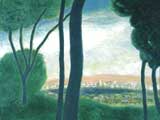
disseminationCanvas from 1952: project helps to organize information on Brazilian artdissemination
The recent opening of the Tomie Ohtake Institute, in the Pinheiros district of São Paulo, rekindled the sparkle in the eyes of those who resented never having seen again the appearance in the city of large scale cultural installations, since the opening of the São Paulo Cultural Center, 20 years ago. Linked to an office building , this space seems to have been born under the new auspices that steer cultural business: partnership with private enterprise. Planned by Ruy Ohtake, one of Tomie’s sons, the institute has 12 rooms for exhibitions, four rooms for shows, a restaurant, a bookstore, a design shop and a café.
The whole building took four years to be concluded, and was financed by Laboratório Aché, at a total cost of R$ 100 million. The support that FAPESP gave to the Tomie Ohtake Project (for cataloging and analyzing the artist’s work) also contributed to the institute’s success, which is already looked on favorably in cultural circles, mainly because of the events with which it was inaugurated – a retrospect of Tomie Ohtake’s career, a sample of an artist from Minas, Rosângela Rennó, and two collective exhibitions, on architecture and design. The research project was headed by Ricardo Ohtake, another of the artist’s sons and a director of the institute, and by Professor Miguel Wady Chaia, the coordinator of the Nucleus of Studies of Art, Meida and Politics (Neamp), of the Pontifical Catholic University of São Paulo (PUC-SP).
The idea arose four years ago, when Ricardo perceived the need for drawing up a broader catalog of the artist’s work, which is spread over dozens of galleries, collectors and collections in various Brazilian states – not to mention the works located abroad. A first survey had been made on the occasion of a retrospect of the work of Tomie, which took place in 1983 at the Museum of Modern Art of São Paulo (Masp). At the time, some 480 works had been identified in the states of Rio and São Paulo and in Brasilia. The new search for works by Tomie, which also had financial support from Santos Bank, led to a leap from 480 to 1200 works identified – more than a dozen outside the country.
This quantitative growth was followed with a qualitative improvement, brought about by the methodology that Miguel Chaia used for research. “We thought it was important not just to draw up a catalog, but also to finish the research with an analysis of Tomie’s work and career”, says the professor, who had the collaboration of one researcher in Rio and two in São Paulo. Chaia received help in the amount of R$ 61,597.00 from Fapesp, used mainly for providing the equipment, including computers and cameras. Santos Bank pitched in with R$ 77,600.00, used to pay the salaries of the researchers, among other things. “This was a happy partnership between Fapesp and Santos Bank”, reckons Ricardo Ohtake. The result can now be seen in the beautiful book Tomie Ohtake, whose launching coincided with the opening of the institute.
Carried out with the support of the Takano Institute, the publication has texts by Paulo Herkenhoff, Frederico Morais, Agnaldo Farias (the Institute’s curator for the visual arts) and by Chaia himself. The next fruit of the study will be a website with a collection of each one of the works (200 of them have only been located in reproduction form, that is to say, the originals have not been found), summaries of the background of each work – which collectors it has belonged to, in which exhibitions it has been shown, which technique was used -, texts written by specialists (Miguel Chaia, Frederico Morais, Cecília Almeida Salles, Dorothea Passetti, Agnaldo Farias and Fernando Cocchiaralli) and video recordings of statements about the artist.
The site will be available on the Internet in two months, and the texts of the specialists will be published with the support of FAPESP. The researchers on the Tomie Ohtake Project found several documentaries on the artist, one of them, Retrato de Tomie (Portrait of Tomie) made by film-maker Walter Salles Jr in 1988. Chaia did a bibliographical survey of everything that has been published on Tomie in books and the press, and outlined her artistic career, so that the research project may also contribute towards an understanding of the meaning of his work, in the context in which it was produced.
“Tomie is an artist who appeared suddenly (she painted his first picture at the age of 39), and right away showed great artistic consistency”, reckons Chaia. “She unites geometrical art to informalism and to the rhetoric of the single shape. Her work has a cosmic dimension, which makes us reflect on the relations between art and science”, says the professor. “The project also helped us to see the dimension of her public works”, he goes on.
For Ricardo Ohtake, the project financed by FAPESP also has a fundamental importance for helping to organize information on Brazilian art. “It will be a great help to the work of curators, historians, art critics and students”, explains the researcher. “If a job of this kind were done for each one of Brazil’s artists, it would be much easier to write the history of Brazilian art”, he concludes.
Republish